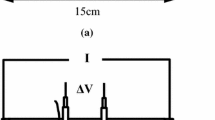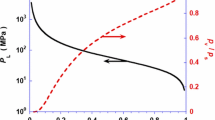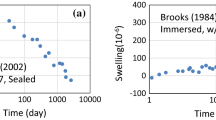Abstract
Crack sensitivity calculations for young concrete are strongly influenced by the coefficient of thermal expansion (CTE) values for the concrete. This paper demonstrates the strong effect of moisture content on CTE, and discusses the mechanism(s) based on experimental results on mature cement paste. The temperature variation of the relative humidity (RH) exerted by the pore water is quantified and used to explain the high CTE of partly dried specimens. The relevance for early age crack sensitivity is that the concrete should be kept as wet as possible. This minimizes CTE and will largely eliminate autogenous shrinkage. However, trustworthy procedures to separate autogenous- and thermal deformations require a better fundamental understanding of moisture effects and the nature of delayed deformations.
Similar content being viewed by others
References
Bjøntegaard Ø (1999) Thermal dilation and autogenous deformation as driving forces to self-induced stresses in HPC, Doctoral thesis. The Norwegian University of Science and Technology, Dept. of Structural Eng., ISBN, 82-7984-002-8.
Bjøntegaard Ø, Sellevold EJ (2001) Interaction between thermal dilation and autogenous deformation in HPC. Materials and Structures, 34:266–272.
Meyers SL (1951) How temperature and moisture changes may affect the durability of concrete. Rock Products, 153–178.
Helmuth RA (1960) Dimensional changes of hardened portland cement pastes caused by temperature changes. Highway Research Board pp. 40:315–336.
Dettling H (1964) Thermal dilation of cement paste, aggregate and concrete (only available in German). Deutscher Ausschuss für Stahlbeton, Heft 164, Berlin.
Bazant ZP (1970) Delayed thermal dilatations of cement paste and concrete due to mass transport. Nuclear Eng. and Design, 308–318.
Bjøntegaard Ø, Sellevold EJ (2001) Thermal dilation and autogenous deformation. Proc. of the RILEM Int. Conf. on Early Age Cracking in Cementitious Systems, Ed. by K Kovler, A Bentur, Haifa, Israel, March 12–14, pp. 63–70.
Scherer GW (2000) Measuring permeability of rigid materials by a beam-bending method: I, Theory. J. Am. Ceram. Soc., 83(9):2231–2239.
Ai H, Young JF, Scherer GW (2001) Thermal expansion kinetics: Methods to measure permeability of cementitious materials: II, application to hardened cement pastes. J. Am. Ceram. Soc., 84(2):385–391.
Radjy F, Sellevold EJ, Hansen KK (2003) Isosteric vapor pressure – temperature data for water sorption in hardened cement paste: Enthalpy, entropy and sorption isotherms at different temperatures. Report BYG-DTU R-057, Techn. Univ. of Denmark, Lyngby. Available at http://www.byg.dtu.dk/publicering/rapporter/R-057.pdf.
Nilsson L-O (1987) Temperature effects in RH measurements on concrete – some preliminary studies. The Moisture Group, Report :1, BFR, 84.
Persson B (2001) Compatibility between flooring material on concrete and moisture, volatile organic compound, and adhesion. Working Report, Division of Building Materials, Lund Institute of Technology, Lund p. 29. (in Swedish).
Hansen W (1987) Drying shrinkage mechanisms in portland cement paste. J Am Ceram Soc 70(5):323–328.
Sjøberg A, Nilsson, L-O, Rapp T (2002) Publikation P-o2:1, Measuring moisture in heated concrete floors. Step 1: Pre-study (available only in Swedish), Inst. for Byggnadsmaterial, Chalmers Tekn. Høgskola, Gøteborg, Sweden.
Powers, TC (1958) The physical structure and engineering properties of concrete. Research Dep. Bulletin 90, Portland Cement Association, Chicago.
Author information
Authors and Affiliations
Rights and permissions
About this article
Cite this article
Sellevold, E.J., Bjøntegaard, Ø. Coefficient of thermal expansion of cement paste and concrete: Mechanisms of moisture interaction. Mater Struct 39, 809–815 (2006). https://doi.org/10.1617/s11527-006-9086-z
Received:
Accepted:
Published:
Issue Date:
DOI: https://doi.org/10.1617/s11527-006-9086-z




